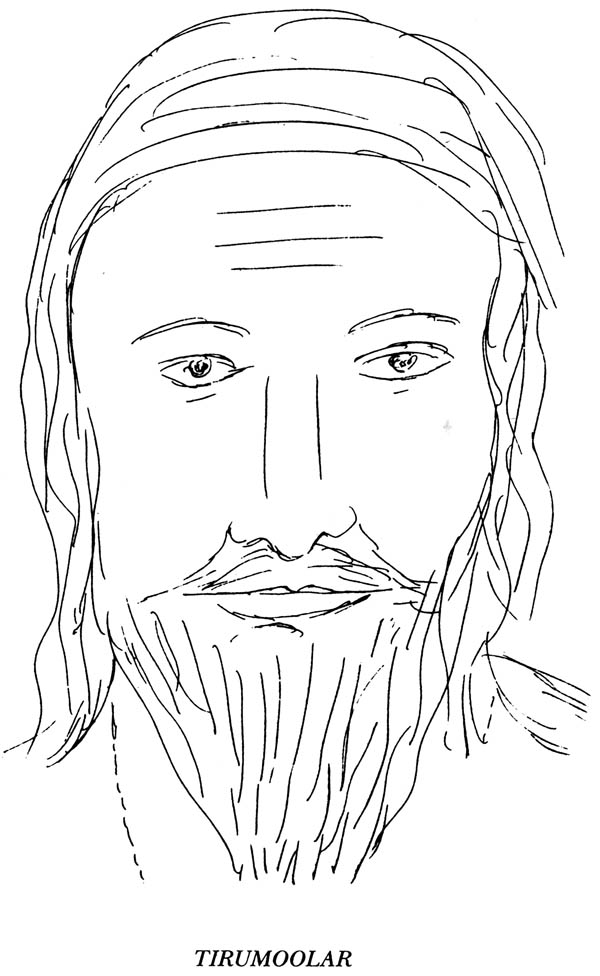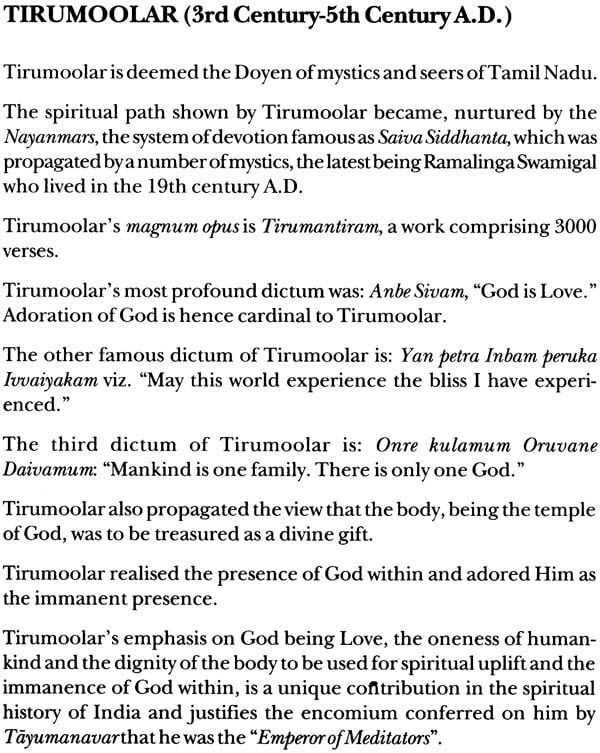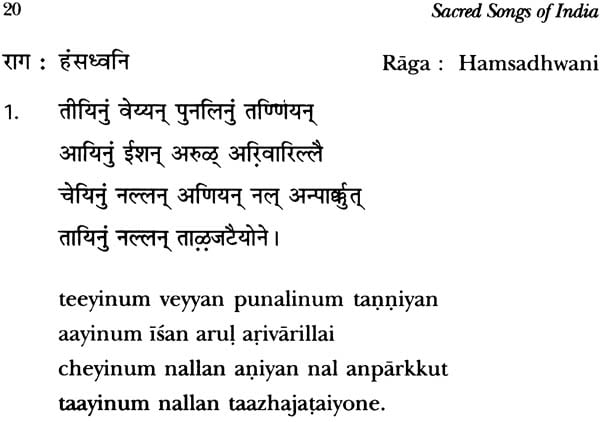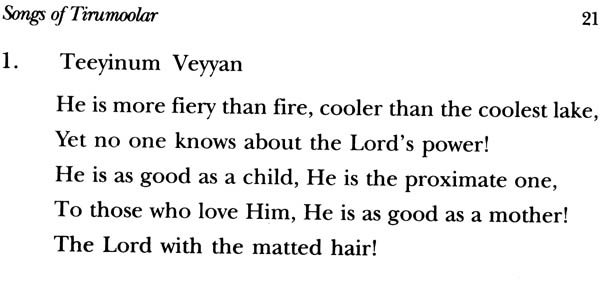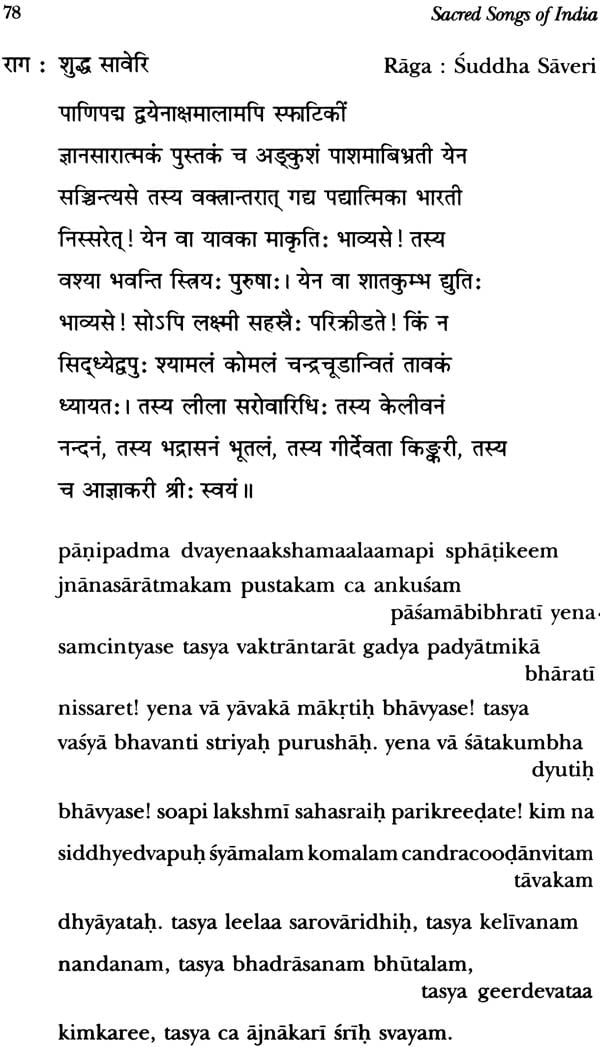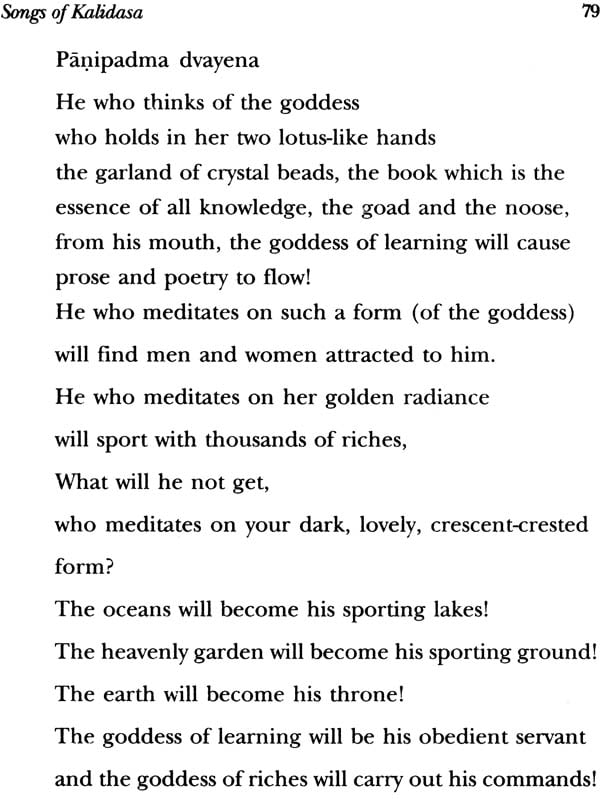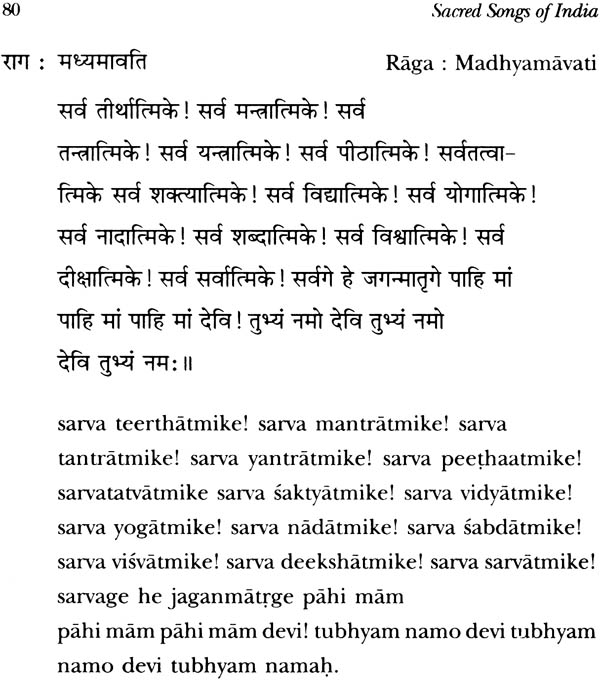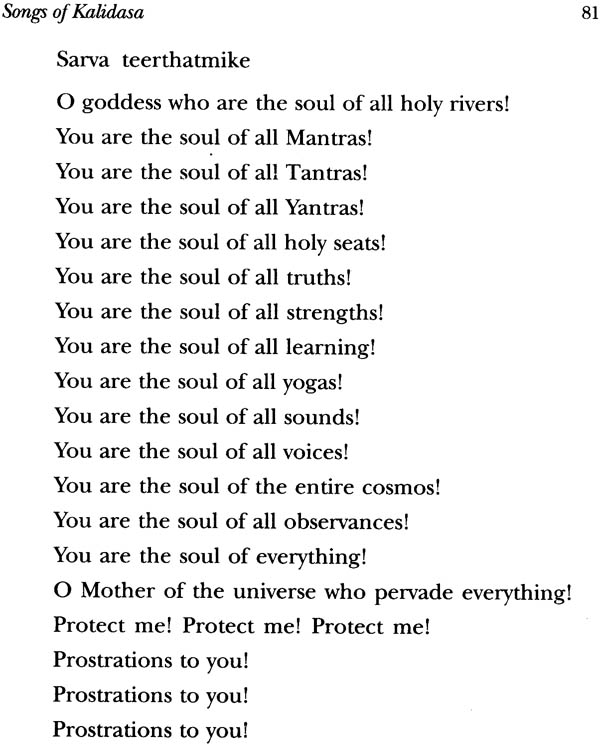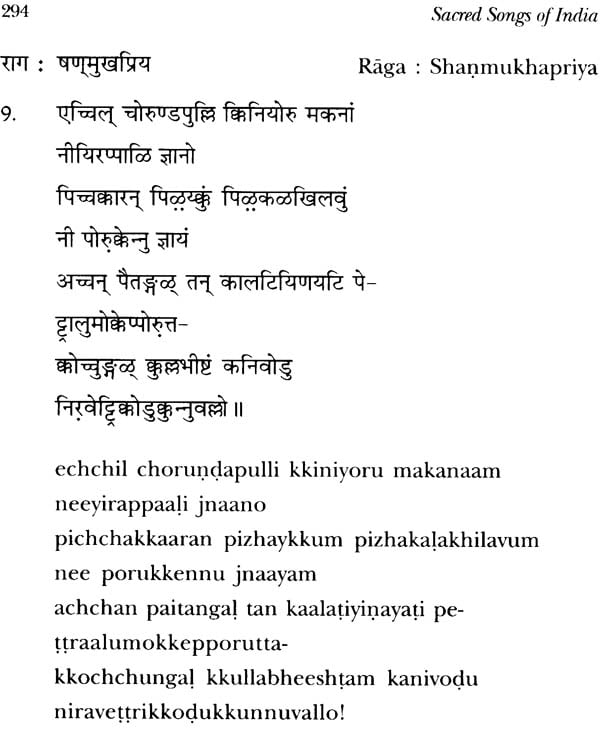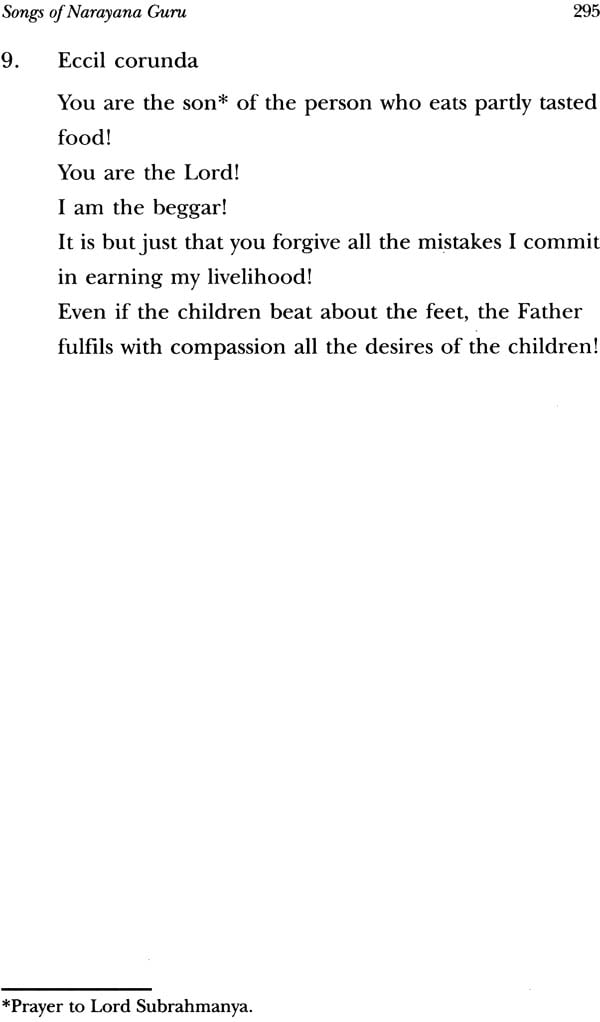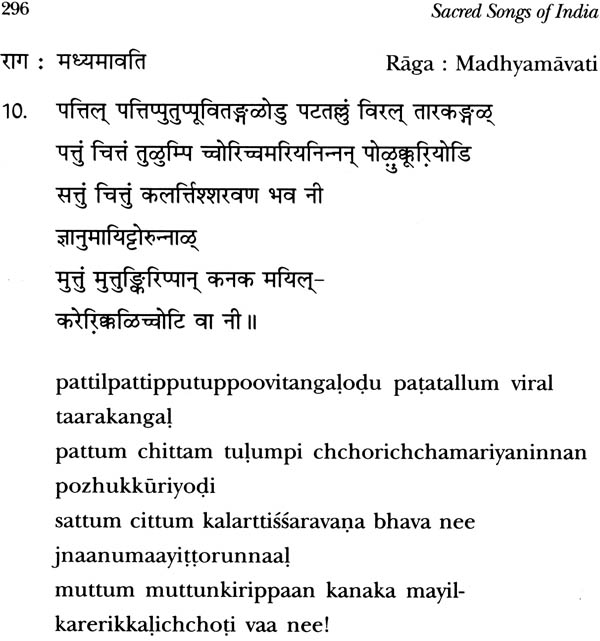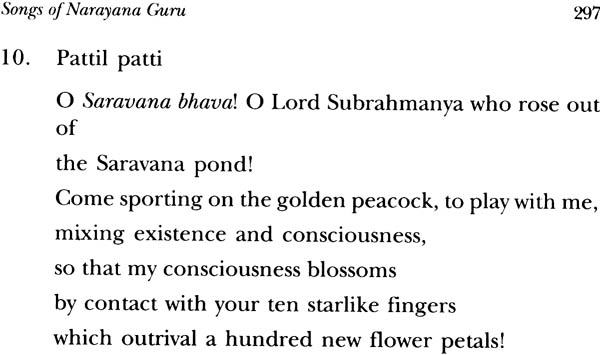
Sacred Songs of India (Vol. VIII)
Book Specification
| Item Code: | IDI132 |
| Author: | V. K. Subramanian |
| Publisher: | ABHINAV PUBLICATION |
| Language: | English |
| Edition: | 2006 |
| ISBN: | 97881701743255 |
| Pages: | 297 (Black & White Figures: 10) |
| Cover: | Hardcover |
| Other Details | 5.6"X 8.7" |
| Weight | 520 gm |
Book Description
This volume SACRED SONGS OF INDIA VOLUME EIGHT represents the eighth milestone in my voyage of discovery of the devotional lyrics of the mystic saints of India, who lived in different regions of India, in different languages.
I have been elevated by me association with the lives and work of these mystics, whose passionate yearning to unite with the infinite Divine has a running thread of unity, which transcended the barriers of class, caste, gender, language, region and time.
The mystic poet sages included in this volume are:Tirumoolar, Kalidasa, Kulasekhara Perumal, Kamban, Devara Dasimayya, Guru Ramdas, Rahim, Appayya Dikshitar, Bhima Bhoi and Sri Narayana Guru.
They lived between in third century A.D. and the twentieth century A.D.
They came from such diverse regions of India as Tamil Nadu, Punjab, Orissa, Madhya Pradesh, Kerala, Karnataka and Uttar Pradesh.
They sang in Sanskrit, Tamil, Punjabi, Hindi, Oriya and Malayalam.
Tirumoolar, who lived probably between the third and fifth century A.D., is the pioneer of the system of devotion known as Saiva Siddhanta, which was nurtured by the Saivite saints of Tamil Nadu, known as Nayanmars. Tirumantiram, which contains 3000 verses and deals with the Yoga path to liberation.
Tirumoolar is unique among the mystics in stressing the importance of the body as a vehicle for spiritual uplift.
He emphasised the oneness of humankind and the fact that God is love also that God was immanent within the human body.
Nevertheless, God to Tirumoolar was the Divine Manifestation: Siva, the Auspicious One, whose dance symbolised the moving phantasmagoria of the cosmos.
Kalidasa, the greatest Sanskrit poet, who lived in the Sixth century A.D., during the Golden Age of the King Vikramaditya, reveled in sensory enjoyment and treated life as a festival.
His outstanding literary output is attributed to the grace of the Divine Mother, to whom Kalidasa poured out his devotion and gratitude in the immortal prayer: Syamala Dandakam (included in this volume), a devotional song recited throughout the length and breadth of India by all, old and young, who seek literary skills and success in scholastic studies.
Kalidasa worshipped God as Father-Mother, as indicated in his famous benedictory invocation in the work Raghuvamsa.
Vagarthaviva samprktau vagarthapratipattaye, Jagatah pitarau vande parvati Paramesvarau.
" I bow to the parents of the universe, Parvati and Paramesvara, who are as united as words and their meaning, so that I may attain skill in words and their interpretation."
The three benedictory invocations in honour of Lord Siva, the Auspicious One, preceding the three plays Malavikagnimitram, Vikramorvasiyam and Sakuntalam are unmatched for their poetic majesty and humble devotion. They are a veritable spiritual treat, when sung melodiously. These have been included in this volume.
Also included is Kalidasa's famous Navaratnamala, a song in nine verses in honour of the Divine Mother.
Kulasekhara Perumal the Kerala King who lived in the 6th-7th century A. D. is one of the twelve Alwars, the Vaishnavite saints of Tamil Nadu.
It is amazing that Kulasekhara Perumal was so proficient with the Tamil language in his devotional songs.
The intensity of devotion in his case made him identify himself with the characters in religious lore.
Thus, in one of his songs, he expresses empathy with the lot of Devaki, Krishna's biological mother from whom/Krishna was separated and sent to foster parents in Brindavan: Nanda and Yasoda.
In another song, he expresses anguish at the lo of Rama who had to wander in the forest for fourteen years, at the behest of his step mother.
Such intensity of devotion is unparalleled and makes Kulasekhara Perumal one of the greatest Alwars and a mystic who expresses symbolically the anguish of the devotee in being separated from the Beloved, God.
Devara Dasimayya, the Karnataka saint who lived in the tenth century A. D., was the earliest poet to introduce the Vacana form of devotional song, which expresses in short verses the intensity of devotion of the mystic sage.
Later savants of the Veerasaivite movement like Basavanna, Allama Prabhu and Mahadevi Akka fully utilized this form in their devotional songs.
Guru Ramdas, the fourth Sikh Guru who lived between 1534 A. D. and 1581 A. D. continued the tradition of earlier Gurus in stressing the importance of chanting the Lord's name as a means to get rid of the ills that afflict mortal life and attain union with God. The unmistakable influence of Vaishnavism continues to be seen in the songs of Guru Ramdas as in the case of other Sikh Gurus.
To Guru Ramdas, as to other Sikh Gurus, God was: Hari, Rama, Govind, Madhusudan, Murari, Narahari etc.: names which are music to the ears of Vaishnavite saints like the Alwars. Rahim, the Muslim mystic, who lived in the 16th century A. D. a contemporary of Emperor Akbar and saint Tulsidas-was madly in love with the cloud-hued form of Krishna, the Lover of the cowherdesses and described His amoral exploits with devotion and poetic skill.
Appayya Dikshitar, who lived in the 16th-17th century A. D., was a renowned scholar and mystic poet of South India.
He was, like many other mystics of India, diffident about the adequacy of his love and devotion for God. To test his devotion, he drank a poisonous drink, which made him delirious. What came out of him in the delirious state would indicate correctly what was really in his heart.
The words which came out of Appayya Dikshitar were taken down by his disciples. These turned out to be the fifty verses called Atmarpana Stuti (Hymn of self-surrender), selections from which are included in this volume.
As can be seen, these verses are soaked in devotion and desperately plead with the Lord to save the devotee.
Bhima Bhoi, the blind tribal mystic, who lived between 1849 A. D. and 1894 A.D., is in a class by himself.
While most mystics poured out their devotion to some specific divine manifestation like Krishna, Rama, Siva, Ganesa or Subrahmania, Bhima Bhoi preferred to adore Him as the formless, elusive One, who pervades everything as the unseen Power. His spiritual path is termed Mahima Dharma.
Sri Narayana Guru, the poet sage of Kerala, who lived between 1856 A. D. and 1928 A. D. was basically a social reformer who stood for abolition of caste distinctions. His famous exhortation was: "One caste, One religion, One God" Like the Advaitic philosopher Sankaracharya, Narayana Guru believed in the omni-presence and immanence of God.
Yet, like Sankaracharya, he composed beautiful devotional songs to various manifestations of Divinity like Ganesa, Subrahmania, Siva, the Divine Mother, etc. which, as can be seen from the selections in this volume, are so full of spiritual fervour and philosophic truths.
Thus, in this volume, we have a wonderful fare, comprising the life work of mystics who were kings as well as poor tribal folk, poets who were literary giants like Kalidasa and Kamban and others who, regardless of their professed religion, adored God in unconventional ways.
Once again, it is my privilege and good fortune to present the songs of these mystics, who came from such varied backgrounds and from such different period of time, and yet through whose outpourings runs the common thread of God-intoxication.
I welcome my readers to savour with relish this ambrosial cocktail of spirituality.
From the Jacket
THE SACRED SONGS OF INDIA VOLUME EIGHT, like its predecessor volumes, encompasses selections from the life work of ten mystic poet-saints of India.
The mystic poet-sages included in this volume lived between the 3rd century and the 20th century A.D. and came from such diverse regions of India as Tamil Nadu, Madhya Pradesh and Orissa.
They are: Tirumoolar, the Doyen of Saivite saints of Tamil Nadu, Kalidasa, the National poet of India, who hailed from Ujjain, Kulasekhara Perumal, the king of Kerala who chose the spiritual path in preference to military adventures, Kamban, the undisputed Emperor of Tamil poets, whose Tamil rendering of the Ramayana is an incomparable classic, Devara Dasimayya, the pioneer of Veerasaivism from Karnataka, Guru Ramdas, the fourth Sikh Guru, Rahim, the Pathan poet who was smitten with love for Krishna, the darling of the Gopis, Appayya Dikshitar, the Saivite poet-philosopher of Tamil Nadu, Bhima Bhoi, the blind tribal mystic of Orissa who yearned for God, the invisible, elusive One and Sri Narayana Guru, the saint from Kerala who was also a great social reformer.
They sang in different languages: Tamil Sanskrit Kannada, Punjabi, Hindi (Braj bhasha), Oriya and Malayalam.But all of them sang of the glory of the God, for whom they sang of the glory of God, for whom they yearned, pouring out their devotion in inimitable immortal poetry.
Like its predecessor volumes, Sacred Songs of India, Volume Eight, will be a valuable repertoire for all artistes in the field of music, dance, drama and ballet and a priceless source of reference for scholars of India's spiritual history.
Vadakaymadom Krishna Iyer Subramanian (b. 1930, Kerala, India) is an eminent scholar, whose life mission is to present to the world the treasures of ancient India, in the fields of art, literature, philosophy and religion.
He has already translated several ancient texts into English.
These include: Saundaryalahari, Sivanandalahari, Sacred Songs of India, Maxims of Chanakya, Sri Rudraprasna and Wondrous Whispers of Wisdom from Ancient India.
As a consultant for holistic health and spiritual development, he has spelt out the Hindu regimens in this regard in his popular book The Holistic Way to Health, Happiness and Harmony.
Subramanian's prolific literary output covers a variety of subjects ranging from astrology to art. He has been an astropalmic counsellor for over 35 years.
A retired officer of the Indian Audit and Accounts Service (which he joined in 1953), Subramanian is also a reputed painter, who has held 22 one-man shows and whose paintings (some of them in the Chandigarh Museum) have won wide acclaim from leading art critics of India.
Subramanian who has traveled extensively in India, now lives in the United States of America.
| Acknowledgements | 9 | |
| introduction | 11 | |
| 1 | Songs of Tirumoolar (3rd-5th Century A. D.) | 17 |
| 2 | Songs of Kalidasa (6th Century A.D.) | 41 |
| 3 | Songs of Kulasekhara Perumal (6th -7th Century A.D.) | 93 |
| 4 | Songs of Kamban (9th Century A.D.) | 117 |
| 5 | Songs of Devara Dasimayya (10th Century A.D.) | 141 |
| 6 | Songs of Guru Ramdas (1534 A.D.-1581 A.D.) | 165 |
| 7 | Songs of Rahim (16th Century A.D.) | 191 |
| 8 | Songs of Appayya Dikshitar (16th -17th Century A.D.) | 213 |
| 9 | Songs of Bhima Bhoi (1849 A.D.-1894 A.D.) | 241 |
| 10 | Songs of Sri Narayana Guru (1856 A.D.-1928 A.D.) | 273 |
